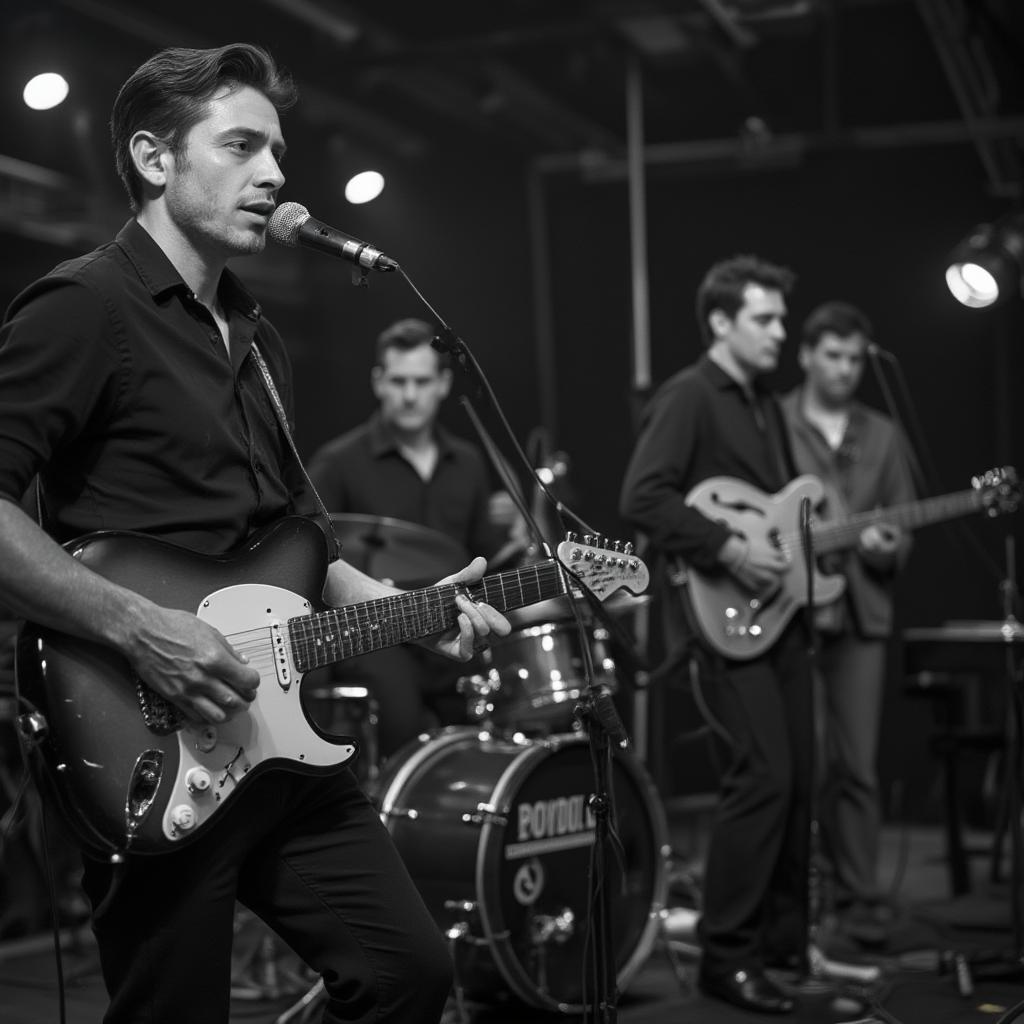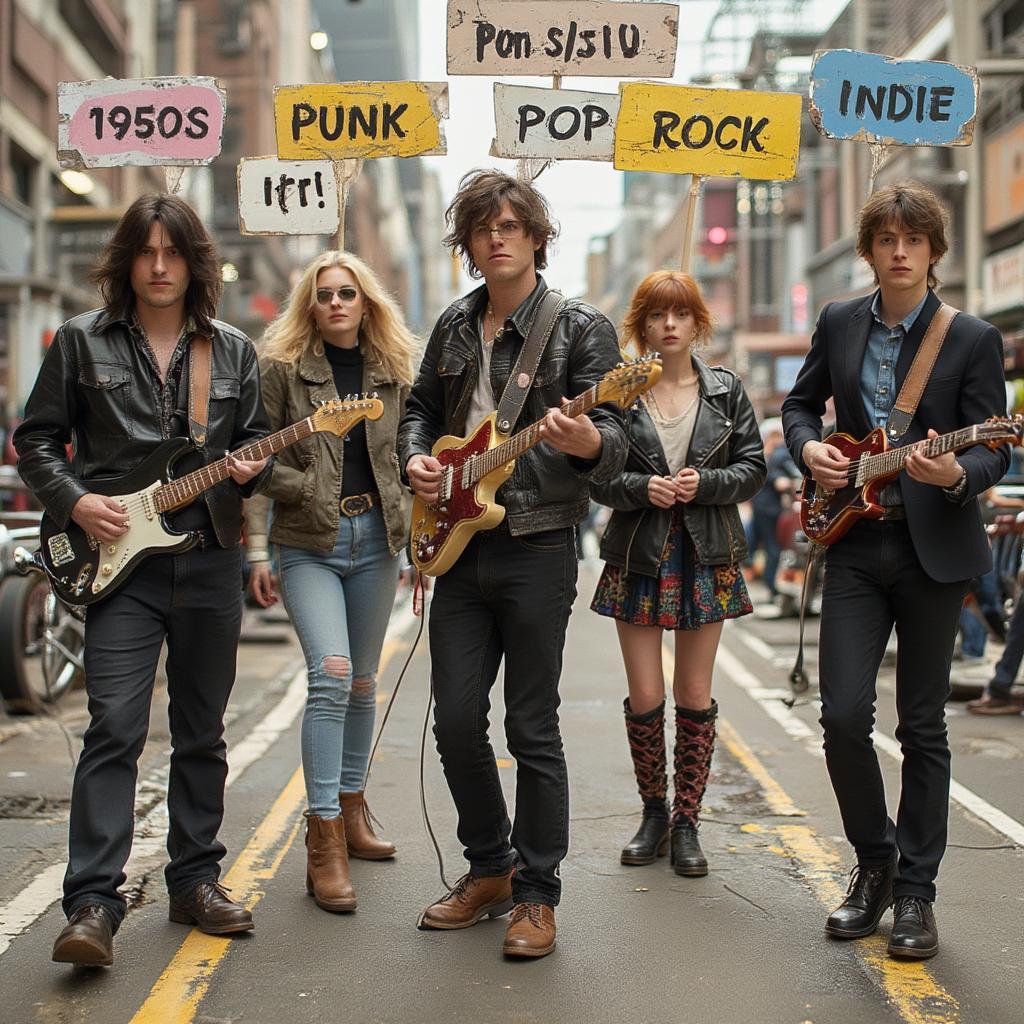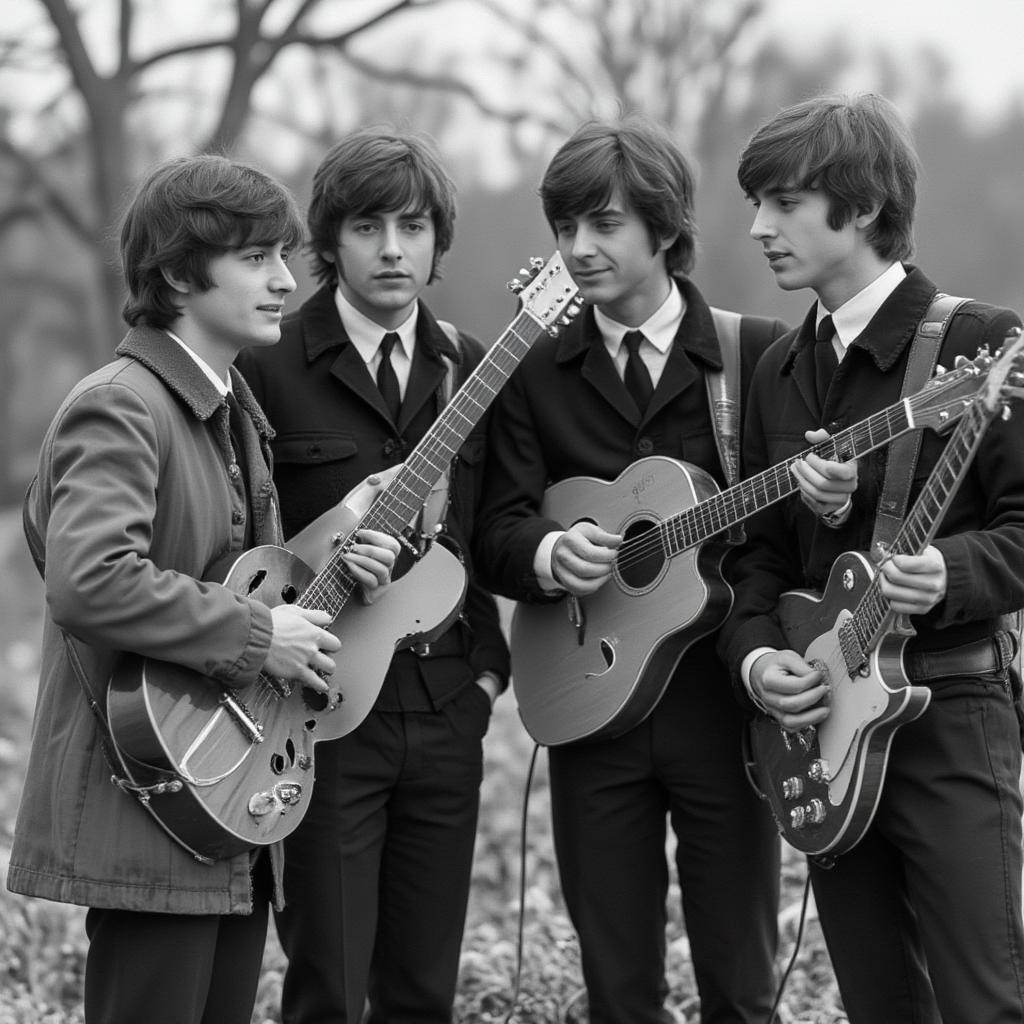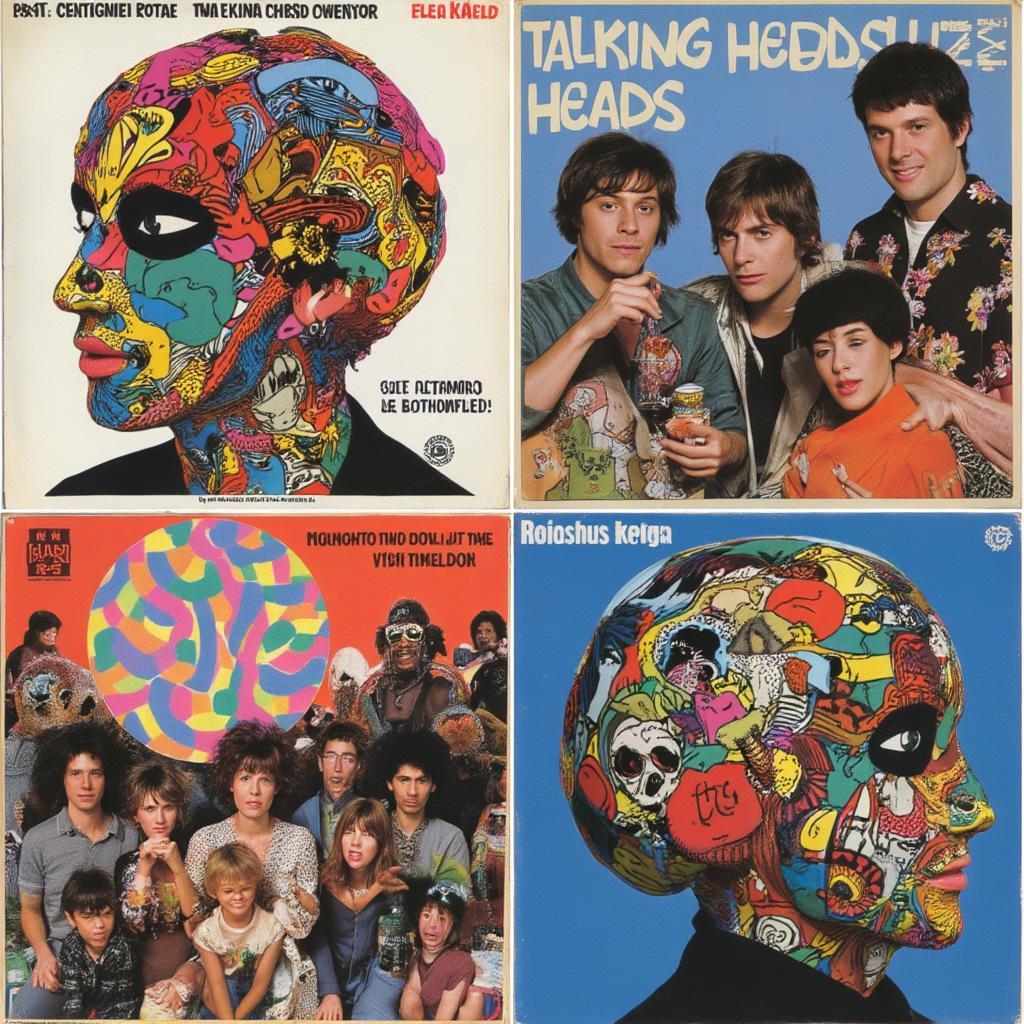Dive into the Heartbeat of 50s Rock and Roll: A Genre That Shaped Generations

The 1950s, a decade synonymous with poodle skirts, drive-in movies, and the electrifying sound of 50s Rock And Roll. This genre, more than just music, was a cultural revolution. It was a rebellion against the status quo, a vibrant explosion of energy that continues to captivate audiences today. Let’s delve into the roots, the key players, and the enduring legacy of this iconic sound.
The Birth of a Revolution: How 50s Rock and Roll Emerged
The genesis of 50s rock and roll wasn’t a singular event; it was a fusion of various musical styles. Imagine the blues’ raw emotion, the gospel’s fervent passion, and country’s storytelling combined with the big band swing of the 40s, all amplified and given a youthful, rebellious twist. This potent mix created a sound unlike anything heard before, sparking a social and musical upheaval. The end of World War II also contributed to the rise of this sound as disposable income allowed people to buy records, leading to the rise of the pop music star.
The Rhythms that Drove the Craze: Instrumentation and Sound
What were the core elements of this sound? The electric guitar, loud and distorted, took center stage, becoming the symbol of 50s rock and roll. The thumping backbeat, typically provided by a drum kit, drove the music forward, creating an irresistible pulse. The upright or electric bass provided the low end, grounding the sound. Often, a piano or saxophone would add another layer of texture and melody. The combination of these instruments, played with a raw energy and attitude, was what defined the 50s rock and roll sound.

“The raw energy of 50s rock and roll is unlike anything else. It was an expression of youth, a cry for freedom, and it resonated with a generation ready to break free from old conventions,” reflects Dr. Amelia Stone, a renowned music historian specializing in mid-20th century American music.
Key Artists Who Defined the Era
The 50s rock and roll scene was populated by legendary figures whose names are etched in music history. Elvis Presley, with his hip-shaking performances and charismatic stage presence, became the face of the genre. Chuck Berry’s innovative guitar riffs and storytelling lyrics propelled him to stardom. Little Richard’s flamboyant performances and piano-pounding boogie-woogie rhythms brought a frenetic energy to the stage. Buddy Holly, with his bespectacled charm and songwriting prowess, added a touch of innocence and vulnerability. These were just a few of the artists that helped shape the sound that came to be known as 50s rock and roll.
The Cultural Impact of 50s Rock and Roll
The influence of 50s rock and roll transcended music, permeating fashion, dance, and even social attitudes. Let’s look at some ways this genre impacted culture.
Beyond the Music: Fashion, Dance, and Social Change
The music became inextricably linked with a certain look. Think of the iconic leather jackets, blue jeans, and slicked-back hair for the guys. The girls wore poodle skirts, saddle shoes, and colorful scarves. This was a departure from the conservative styles of previous decades, embodying the rebellious spirit of the music. New dances like the “jitterbug” and “hand jive” also emerged, allowing people to express themselves with free-flowing movement. The music broke down racial barriers as well, bringing together black and white musicians and audiences, leading to a more integrated musical landscape. This change was, however, met with some resistance from the older generations, who were afraid of the perceived “vulgarity” of the music.
“The energy of the music created a cultural shift. The clothing, the dancing, everything was intertwined. It was a way for young people to express themselves and break away from the norms of their parents generation,” explains Professor Charles Edwards, a sociology professor who studies the impact of music on society.
The Enduring Legacy of 50s Rock and Roll
Even though decades have passed, the 50s rock and roll era continues to inspire. Its influence can be seen in countless genres, from punk rock to indie rock and even pop music. Many modern artists cite the pioneers of 50s rock and roll as their musical heroes. The raw energy, catchy melodies, and rebellious spirit of 50s rock and roll still resonate with audiences today, proving that its appeal is timeless. If you are looking to explore more artists from the era, you can learn more with our article on rock and roll hall of fame eligibility 2022.
The Sound and Feel: Identifying 50s Rock and Roll
Let’s get down to the specifics – how exactly can you identify this iconic music?
Distinguishing Characteristics: Elements of the Sound
When listening to a song, there are some common sounds to listen for in order to properly classify a 50’s rock and roll song. Firstly, listen for the prominent use of the electric guitar as this is one of the defining characteristics of the genre. Many of the songs utilize a standard 12 bar blues progression. Pay attention to the heavy backbeat, usually provided by drums, which provides an insistent rhythm for listeners to tap their feet to. There’s also a tendency to utilize simple chord progressions and catchy melodies to create a feeling that is easy to sing along to. Also note the use of raw, unpolished vocals, and the use of the musical styles mentioned earlier: blues, country, gospel, and swing.
How 50s Rock and Roll Influenced Later Music
The impact of the 50s rock and roll sound is evident in countless later genres. Punk rock took the raw energy and rebellious attitude from 50s rock and roll. The simplicity and catchiness of 50s melodies are evident in pop music, particularly in the music of bands like The Beatles and The Rolling Stones, who were heavily influenced by the early stars of rock and roll. You can even hear its impact on the independent scene of today with many indie rock bands utilizing a similar setup as the early stars of rock and roll. To learn more about the people that are honored for their impact on the music industry, check out the 2022 rock and roll hall of fame nominees.

“The simplicity of 50s rock and roll is its greatest strength. It gave later musicians a starting point, a blank canvas, if you will, to build upon. It is, in essence, the foundation of modern popular music,” states Thomas Baker, a music producer specializing in rock genres.
Tia Chớp Đỏ: Carrying the Torch of 50s Rock and Roll
As “Riffmaster” Nguyễn of Tia Chớp Đỏ, I see us as inheritors of this vibrant legacy. We are determined to inject the raw energy, the rebellious spirit, and the sheer joy of 50s rock and roll into our music. Our goal is to honor the pioneers while pushing boundaries and creating our own unique sound within the genre. We aim to be a modern representation of the spirit of 50s rock and roll, and we seek to do this through our music, stage presence, and overall creative output.
Our sound will be a high-octane fusion of classic 50s rock and roll elements, with a touch of modern grit and attitude. We aim to bring back the energy of early rock and roll concerts and combine them with our signature modern flair. We want to create music that makes people move, feel, and connect with the passion that fuels this genre. We look to capture the magic of the era and introduce it to a new generation, but you can also explore the past by learning about rock and roll hall of fame 2022.
Conclusion: The Timeless Appeal of 50s Rock and Roll
50s rock and roll was more than just a musical fad; it was a cultural phenomenon that shaped generations and continues to influence music today. Its rebellious spirit, catchy melodies, and raw energy still resonate with audiences, proving that the magic of 50s rock and roll is truly timeless. We at Tia Chớp Đỏ are ready to carry that torch forward and show you what this iconic sound can still be.
FAQ About 50s Rock and Roll
Here are some frequently asked questions about 50s rock and roll.
1. What are the key characteristics of 50s rock and roll music?
The genre is characterized by its use of electric guitars, a strong backbeat, simple chord progressions, and raw, unpolished vocals. Its roots lie in blues, country, gospel, and swing music, all mixed together to create a new, unique sound.
2. Who were the most influential artists of the 50s rock and roll era?
Some of the most important and influential artists include Elvis Presley, Chuck Berry, Little Richard, Buddy Holly, and Jerry Lee Lewis, who were all pioneers of this genre and created many iconic songs that are still popular today.
3. How did 50s rock and roll impact fashion and culture?
50s rock and roll had a huge impact on fashion, leading to the popularity of leather jackets, blue jeans, and poodle skirts. It also spurred the development of new dance styles and a more rebellious attitude among young people.
4. What is the difference between 50s rock and roll and rockabilly?
While rockabilly is a subgenre of 50s rock and roll, it incorporates more country and bluegrass elements, giving it a distinctive twangy sound, often utilizing acoustic instruments. It does still have the same rebellious attitude as the greater genre, however.
5. Is 50s rock and roll still relevant today?
Absolutely! 50s rock and roll is still very relevant as its influence can be seen in numerous genres of music today, from punk to indie. Its influence on modern pop music is also extremely apparent, with many artists crediting the pioneers of rock and roll as their inspiration.
6. Where can I find authentic 50s rock and roll music?
You can find authentic 50s rock and roll music on various streaming platforms. There are also several compilations available both in physical and digital formats. You could also explore the rock and roll hall of fame 2022 performances for live examples of this music.
7. What made 50s rock and roll so rebellious?
50s rock and roll was rebellious due to its raw energy, its departure from the standards of the previous generation, and its integration of traditionally Black musical forms, all of which challenged the status quo.


